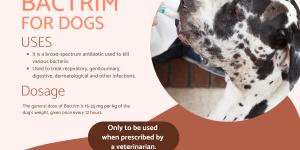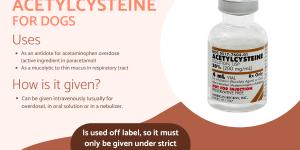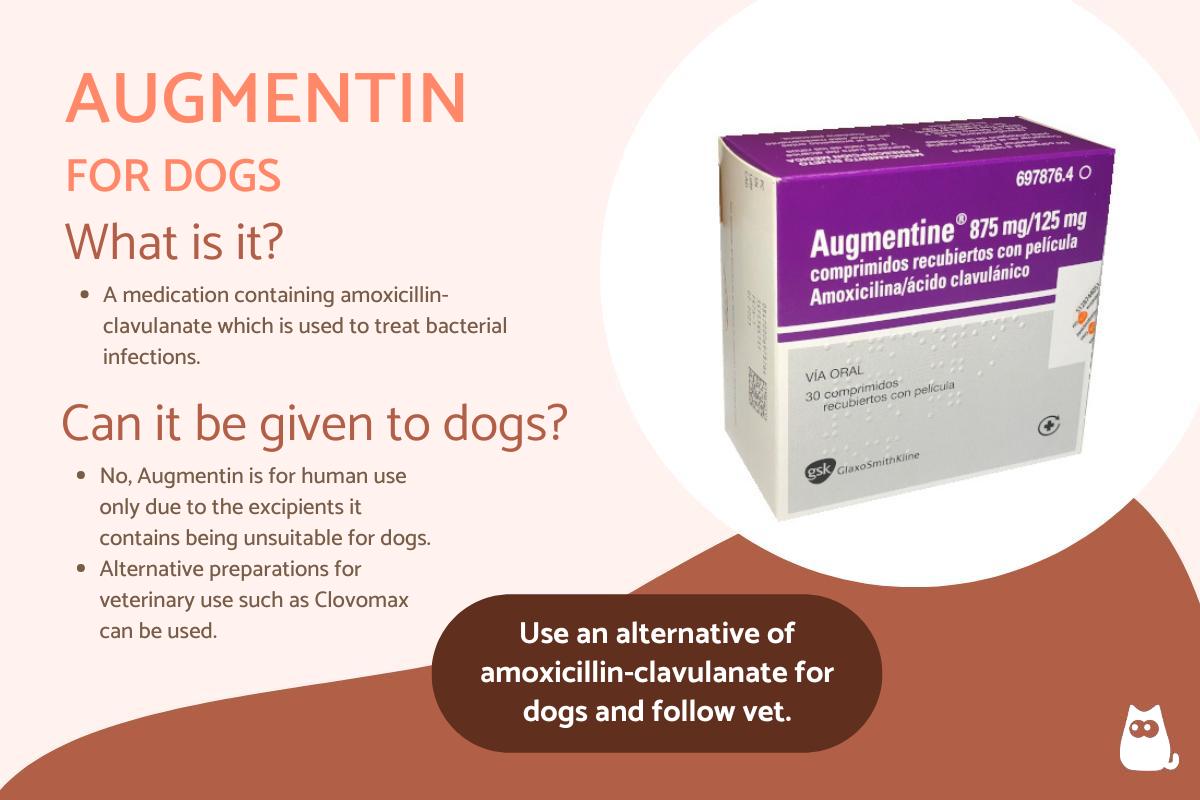Augmentin for Dogs - Dosage and Uses

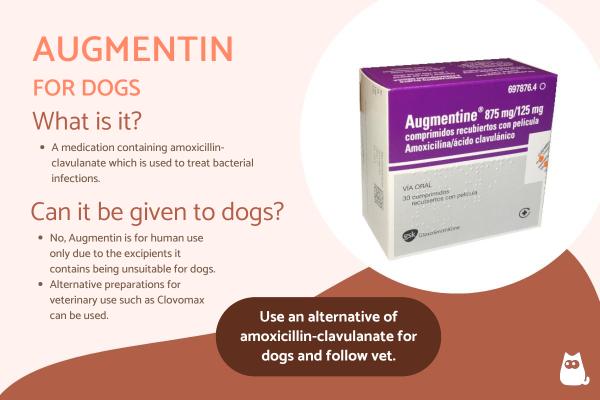

See files for Dogs
Augmentin is a drug that combines amoxicillin and clavulanic acid to create an antibiotic treatment for various bacterial infections. While these active ingredients are used in both human and veterinary medicine, it is vital to know that we cannot give the human preparation to dogs. Doing so could cause an overdose or other adverse effects. Although it can be used to treat various bacterial infections, it is most commonly used for periodontal issues in dogs. Amoxicillin is a drug susceptible to generating antimicrobial resistance, so its use should be limited where possible and an alternative medication can be used.
With AnimalWised, we look at the dosage, uses and side effects of Augmentin for dogs. We also explain why Augmentin itself should not be given, but other preparations of amoxicillin-clavulanate can be effective.
What is Augmentin for dogs?
Augmentin is the trade name of a drug containing amoxicillin, a penicillin-derived antibiotic belonging to the beta-lactam group. Its mechanism of action is to prevent the proper formation of the bacterial cell wall by interfering with the final stage of peptidoglycan synthesis, a key structural component of this wall. As a result, the cell wall is weakened, leading to lysis and death of the bacteria.
Amoxicillin is sensitive to degradation by beta-lactamases produced by resistant bacteria. For this reason, in medicines such as Augmentin, it is combined with clavulanic acid. This is an irreversible inhibitor of beta-lactamases. This combination creates amoxicillin-clavulanate, protecting the amoxicillin against beta-lactamase-producing strains and thereby improving the drug's effectiveness.
Can I give Augmentin to my dog?
Augmentin is a medicine that contains the drugs mentioned above, but is marketed for use in humans. It may contain excipients (i.e. ingredients other than the active ingredients) which are unsuitable for canine consumption, such as flavorings or binding agents. While the reaction in the dog may vary, it is best avoided. Veterinarians will prescribe another preparation of amoxicillin-clavulanate which has excipients safe for dogs.
There are options designed for dogs that contain amoxicillin and clavulanic acid in their composition which can have better preparations for use in dogs. These formulations are much more suitable, often better facilitating administration. This is especially useful in small dogs and puppies, whose weight and needs are very different from those of an adult human being.
When talking about the uses and dosage of of Augmentin for dogs, we will be referring to other preparations of amoxicillin-clavulanate which are specifically used for veterinary use. These include the most popular trade name known as Clavamox, although generic forms and other brand names may be available.
Augmentin for dogs uses
As we have explained, Augmentin is not usually given to dogs due to the possibility of negative interactions or overdose. Its veterinary equivalents such as Clavamox for dogs are most often used as direct or adjunctive treatment of oral infections in dogs. Specifically, amoxicillin-clavulanate is used to treat periodontal infections caused by:
- Streptococcus spp.
- Escherichia coli
- Pasteurella spp.
This is because these bacteria are sensitive to the combination of amoxicillin and clavulanic acid. In addition, this medication can be used in other canine infections, such as:
- Superficial and deep pyodermas
- Urinary infections
- Abscesses
- Respiratory infections
- Anal sacculitis
- Bacterial enteritis
Discover more about the causes and treatment of some of these uses for Augmentin in dogs with our articles on canine abscess types and intestinal inflammation in dogs.
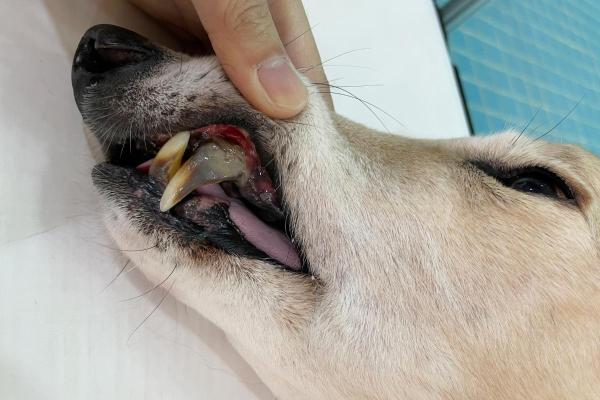
Augmentin for dogs dosage
The dosage of Augmentin for dogs alternatives such as Clavamox is administered in canines at a rate of 10 mg of amoxicillin and 2.5 mg of clavulanic acid per kilogram of body weight. It is adminstered orally twice a day. In cases of severe periodontal infections, the dosage can be doubled, reaching 20 mg of amoxicillin and 5 mg of clavulanic acid per kilogram of body weight, also given twice a day.
Medications formulated for dogs combine both active ingredients in an appropriate proportion. Therefore, it is essential to use an amoxicillin-clavulanate drug for dogs and not Augmentin for human use.
The duration of treatment varies depending on the type of infection. For example, in the case of periodontal infections, it is usually about seven days. For more details on this infection, we recommend checking our article on treating canine periodontitis.
How to give Augmentin to dogs
Before administering amoxicillin-clavulanate to dogs, it is essential to perform an antibiogram to confirm that the bacteria responsible for the infection are not resistant. This helps to avoid a decrease in the effectiveness of the treatment and to reduce the spread of bacteria resistant to this antibiotic.
The medication is usually administered orally and can be mixed with food or given directly into the dog's mouth. Intravenous injections may be used in a clinical setting, but it is very rare to be used at home. We insist that Augmentin for humans should not be given to dogs, so it is necessary to purchase the medication formulated for this species.
Since amoxicillin is a penicillin derivative, it is important to note that in sensitive individuals, direct skin contact, inhalation or ingestion of the drug may cause allergic or hypersensitivity reactions. Sensitive individuals should therefore not handle this drug.
Find out about another preparation of one of these active ingredients with our article on amoxicillin for dogs.
Side effects of Augmentin for dogs
As with all medications, Augmentin can cause side effects in dogs. The main adverse symptoms are usually gastrointestinal, such as vomiting, diarrhea or nausea.
In less common cases, as in humans, the drug may cause skin hypersensitivity reactions or anaphylaxis. Fortunately, anaphylactic shock in dogs due to this drug is rare. If this does occur, the drug should be discontinued immediately and appropriate symptomatic treatment should be initiated.
Contraindications of Augmentin for dogs
As with the side effects, Augmentin also has a number of contraindications for use in dogs. The first of these is that it is a drug formulated for humans, so its use in animals is contraindicated for all dogs. Instead, there are combinations of amoxicillin and clavulanic acid on the market specifically designed for dogs.
The main contraindications of Augmentin-like drugs in the canine species are as follows:
- Pregnant or lactating dogs: should not be used in pregnant or lactating dogs due to the lack of studies supporting its safety at these stages. Although research in rats has not demonstrated teratogenic effects or toxicity to the mother or offspring, its use should be based on a careful risk/benefit assessment by the veterinarian.
- Interaction with other antibiotics: it should not be administered together with other antibiotics such as tetracyclines, macrolides, chloramphenicol or sulfonamides. These may reduce the bactericidal activity of amoxicillin.
- Hypersensitivity: should not be used in dogs with known hypersensitivity to penicillin, other beta-lactams or to the excipients of the drug.
- Severe kidney disease: it is contraindicated in dogs with severe kidney disease presenting with oliguria or anuria.
Learn more about kidney disease with our article on the main causes of renal failure in dogs.
This article is purely informative. AnimalWised does not have the authority to prescribe any veterinary treatment or create a diagnosis. We invite you to take your pet to the veterinarian if they are suffering from any condition or pain.
If you want to read similar articles to Augmentin for Dogs - Dosage and Uses, we recommend you visit our Medicine category.

